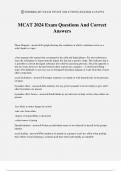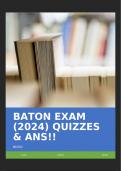©THEBRIGHT EXAM STUDY SOLUTIONS 8/22/2024 12:54 PM
MCAT 2024 Exam Questions And Correct
Answers
Phase Diagram - answer✔✔a graph showing the conditions at which a substance exists as a
solid, liquid, or vapor
a line separates the regions that correspond to the solid and liquid phases. For most substances,
since the solid phase is denser than the liquid, this line has a positive slope. This indicates that it
is possible to convert the liquid substance into solid by increasing pressure. Since the opposite is
true for water, however, the line between these regions has a negative - or downward-tilting -
slope. This hallmark is one easy way to distinguish the phase diagram of water from that of most
other compounds.
social facilitation - answer✔✔stronger responses on simple or well-learned tasks in the presence
of others
bystander effect - answer✔✔the tendency for any given bystander to be less likely to give aid if
other bystanders are present
bystander effect factors - answer✔✔individuals do not intervene to help victims when others are
present
-less likely to notice danger in crowds
-take cues from others
-degree of responsibility is decreased
-cohesiveness of group
Deindividuation - answer✔✔when an individual seems to lose himself or herself in the group's
identity
social loafing - answer✔✔the tendency for people in a group to exert less effort when pooling
their efforts toward attaining a common goal than when individually accountable
, ©THEBRIGHT EXAM STUDY SOLUTIONS 8/22/2024 12:54 PM
group polarization - answer✔✔the enhancement of a group's prevailing inclinations through
discussion within the group. doesn't have to be irrational.
normative social influence - answer✔✔behavior that is motivated by the desire to gain social
acceptance and approval
informational social influence - answer✔✔influence resulting from one's willingness to accept
others' opinions about reality
Groupthink - answer✔✔the mode of thinking that occurs when the desire for harmony in a
decision-making group overrides a realistic appraisal of alternatives. leads to irrational decisions
by a group.
characteristics of group think - answer✔✔invulnerability, rationalization, lack of introspection,
stereotyping, pressure, lack of disagreement, self-deception, insularity
Irving Janis and groupthink - answer✔✔members of a group are so driven to reach unanimous
decisions that they no longer truly evaluate the consequences of their decisions
occurs when the groups making decision are isolated and homogeneous, there is a lack of
impartial leadership inside or outside the gorup, when there is a high level of pressure for a
decision to be made
Conformity - answer✔✔when someone's behavior, beliefs, or thinking changes to line up with
the perspective of others
compliance - answer✔✔when the person conforms but internally dissents
Conversion - answer✔✔genuine change in someone's beliefs
Asch Experiment - answer✔✔experimented how people would rather conform than state their
own individual answer even though they know the group's answer is wrong, length of lines
compliance (requests) - answer✔✔responses to requests from someone with no power to enforce
that request.
foot-in-the-door technique - answer✔✔asking for a small commitment and, after gaining
compliance, asking for a bigger commitment
door-in-the-face technique - answer✔✔asking for a large commitment and being refused and
then asking for a smaller commitment
low-ball technique - answer✔✔persuasive technique in which the seller of a product starts by
quoting a low sales price and then mentions all of the add-on costs once the customer has agreed
to purchase the product
, ©THEBRIGHT EXAM STUDY SOLUTIONS 8/22/2024 12:54 PM
obidience - answer✔✔changing one's behavior at the command of an authority figure
Milgram Experiment - answer✔✔an experiment devised in 1961 by Stanley Milgram, a
psychologist at Yale University, to see how far ordinary people would go to obey a scientific
authority figure with giving electric shocks
Stanford Prison Experiment (Zimbardo) - answer✔✔classic "experiment" where individuals
were assigned to be guards / prisoners. w/in days they took on their roles and went too far.
Highly unethical
social norms - answer✔✔rules, spoken or unspoken, that regulate behavior, beliefs, attitudes,
and values of members of society
social control - answer✔✔the way norms are taught, enforced, and perpetuated
deviance - answer✔✔when someone doesn't follow a norm
formal vs informal norms - answer✔✔Formal:
-generally written down, like *laws*
-precisely defined, publicly presented and have strict penalties for violators
informal: generally understood but less precise and carry no specific punishment
Folkways - answer✔✔insignificant informal norms that involve small details, violating them
does not cause too much of a problem, example: fashion, wearing socks with sandals
mores - answer✔✔informal norms, which incur severe disapproval when violated. ex: cheating
on romantic partner
taboos - answer✔✔even more restrictive norms that generate extreme disapproval. Ex:
cannabalism, incest. Driven by culture. Some are forbidden by law and some aren't.
Anomie - answer✔✔Refers to situation where there is a poor match between society's stated
norms and the norms that an individual responds to
sanctions - answer✔✔punishment or negative consequences for violating a social norm. Rewards
for following social norm.
adding a solute to water will ----- bp and ----- mp, - answer✔✔increase; lower
differential association theory - answer✔✔theory that individuals learn deviance in proportion to
number of deviant acts they are exposed to, and deviance is learned socially, draws from
symbolic interactionism
, ©THEBRIGHT EXAM STUDY SOLUTIONS 8/22/2024 12:54 PM
labeling approach - answer✔✔focuses on how behavior is affected by being labeled as a deviant.
Primary Deviance (Labeling Theory) - answer✔✔the initial act or attitude that causes one to be
labeled deviant
secondary deviance (labeling theory) - answer✔✔subsequent acts of rule breaking that occur
after primary deviance and as a result of your new, deviant label, the stigma attached to it and
people's expectations of you
strain theory - answer✔✔focuses on the role of social and economic pressures towards deviance.
Says that some people would commit crime under straining conditions.
Socialization - answer✔✔how we learn informal and formal norms by interacting with other
people and insitutions
agents of socialization - answer✔✔family, education system, mass media, peers, workplace
Fads - answer✔✔a new behavior that suddenly becomes extremely popular, then fades
mass hysteria - answer✔✔irrational fear of a perceived threat, verging on the point of a
collective delusion
riots - answer✔✔characterized by large # of people who engage in dangerous behavior, such as
vandalism, violence, or other crimes. Deindividation, loss of self identity, occurs. Often violent
and targeted against an established institution or authority figure.
peer pressure - answer✔✔influence from members of one's peer group.
Anaerobic - answer✔✔Process that does not require oxygen
Halophiles - answer✔✔"salt-loving" archaea that live in environments that have very high salt
concentrations
What to the numbers on the bottom of the Element on MCAT Periodic table mean? -
answer✔✔the molar mass of the element in *grams/mol*
How many grams are in a kilogram? - answer✔✔1000
What is molarity? - answer✔✔mol/L
A mole - answer✔✔a number of items equal to Avogadro's number (6.02 × 1023)
a 1 M solution of glucose contains - answer✔✔6.02 × 1023 molecules of glucose in each liter of
solution.
millimolar (mM) - answer✔✔10^-3 M
micromolar (µM) - answer✔✔10^-6 M






